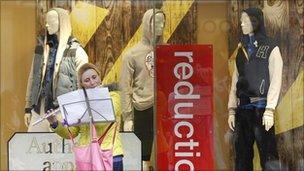Inflation figures were wrong, says Bank of England
- Published

Tracking the ups and downs of clothes prices was particularly tricky
The Bank of England has calculated that inflation was 0.3% higher per year than the figures reported by the Office for National Statistics (ONS).
The under-reporting arose during the 12 years between 1997 and 2009, according to the Bank's statisticians.
This implies that prices ended the period nearly 4% higher than recorded in official figures.
Higher inflation could have resulted in bigger rises in benefits, inflation-linked pensions and some investments.
Clothes
John Broome Saunders, a pension expert at BDO Investment Management, said: "Had the inflation calculation been done correctly, many final salary scheme members would now find themselves entitled to a pension around 4% higher than their actual entitlement."
However, the Department for Work and Pensions (DWP) has told the BBC that it would not be recalculating any payments, even if people felt they had lost out.
It is rare for the ONS to come under attack from the Bank of England.
The inaccurate figures arose from measurements of clothing prices during the period, according to the Bank.
Price fluctuations can be hard to track as styles change, stocks are exhausted and the shelves are refilled.
The ONS "picked up seasonal falls in prices during the winter and summer sales, but did not fully capture the recovery in prices after sales had finished", states the Bank's latest quarterly Inflation Report, external.
'Larger impact'
The study looked at clothing prices in Euro-area countries and estimated the impact on the UK's consumer prices index (CPI) if more accurate clothing prices had been included.
The discrepancy was "equivalent to adding 0.3 percentage points to aggregate annual CPI inflation", the Inflation Report says.
The report suggested that there would have been an even larger impact on the other headline inflation index, the retail prices index (RPI).
The ONS changed its methods for monitoring clothing prices last year.
It increased the number of clothing lines it followed and changed the times of year that prices were checked.
"But this certainly does not mean that there were measurement errors or misreporting in the past," an ONS spokesman told the BBC.
He added that improvements were often made and the weight given to different items of shopping in the RPI or CPI was reassessed every year.
"Certain improvements will increase inflation whilst others will reduce it," he said.
'Theoretical argument'
It is unlikely that members of the public could reclaim any lost money or ask for an increase in pension or benefit income.
The National Association of Pension Funds pointed out that pension increases are dependent on published inflation rates, which remain as they were.
"It's a theoretical argument," explained Ros Altmann, Saga Group director general.
"You would have to prove that this is the only element of inflation that needed to be changed," she said.
The policy of the Department for Work and Pensions is that it will only change benefit rates if the official inflation figure is recalculated and republished.
A DWP spokesperson said: "Inflation figures are determined by the ONS who regularly do work to improve their methods of calculation.
"Any changes in methodology do not mean that previous inflation rates were incorrect."